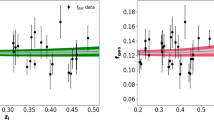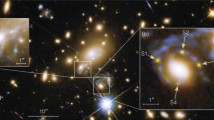Abstract
Gravitationally lensed QSOs (GLQs) at 1≤z≤2 play a key role in understanding the cosmic evolution of the innermost parts of active galaxies (black holes, accretion disks, coronas and internal jets), as well as the structure of galaxies at intermediate redshifts. With respect to studies of normal QSOs, GLQ programmes have several advantages. For example, a monitoring of GLQs may lead to unambiguous detections of intrinsic and extrinsic variations. Both kinds of variations can be used to discuss central engines in distant QSOs, and mass distributions and compositions of lensing galaxies. In this context, UV data are of particular interest, since they correspond to emissions from the immediate surroundings of the supermassive black hole. We describe some observation strategies to analyse optically bright GLQs at z∼1.5, using ISSIS (CfS) on board World Space Observatory-Ultraviolet.
Similar content being viewed by others
References
Alcalde, D., Mediavilla, E., Moreau, O., et al.: Astrophys. J. 572, 729 (2002)
Arévalo, P., Uttley, P., Kaspi, S., Breedt, E., Lira, P., McHardy, I.M.: Mon. Not. R. Astron. Soc. 389, 1479 (2008)
Arévalo, P., Uttley, P., Lira, P., Breedt, E., McHardy, I.M., Churazov, E.: Mon. Not. R. Astron. Soc. 397, 2004 (2009)
Blandford, R.D., Narayan, R.: Annu. Rev. Astron. Astrophys. 30, 311 (1992). See also http://nedwww.ipac.caltech.edu/level5/Blandford/Blandford_contents.html
Cackett, E.M., Horne, K., Winkler, H.: Mon. Not. R. Astron. Soc. 380, 669 (2007)
Cid Fernandes, R., Sodré, L. Jr., Vieira da Silva, L. Jr.: Astrophys. J. 544, 123 (2000)
Collier, S., Peterson, B.M.: Astrophys. J. 555, 775 (2001)
Collier, S., Horne, K., Wanders, I., Peterson, B.M.: Mon. Not. R. Astron. Soc. 302, L24 (1999)
Collin-Souffrin, S.: Astron. Astrophys. 249, 344 (1991)
Eigenbrod, A., Courbin, F., Sluse, D., Meylan, G., Agol, E.: Astron. Astrophys. 480, 647 (2008)
Falco, E.E., et al.: Astrophys. J. 523, 617 (1999)
Fohlmeister, J., et al.: Astrophys. J. 662, 62 (2007)
Gaynullina, E.R., et al.: Astron. Astrophys. 440, 53 (2005)
Gil-Merino, R., González-Cadelo, J., Goicoechea, L.J., Shalyapin, V.N., Lewis, G.F.: Mon. Not. R. Astron. Soc. 371, 1478 (2006)
Goicoechea, L.J., Shalyapin, V.N.: Astrophys. J. 708, 995 (2010)
Goicoechea, L.J., Alcalde, D., Mediavilla, E., Muñoz, J.A.: Astron. Astrophys. 397, 517 (2003)
Goicoechea, L.J., et al.: Astrophys. J. 619, 19 (2005)
Goicoechea, L.J., et al.: New Astron. 13, 182 (2008a)
Goicoechea, L.J., Shalyapin, V.N., Gil-Merino, R., Ullán, A.: Astron. Astrophys. 492, 411 (2008b)
Goicoechea, L.J., Shalyapin, V.N., Ullán, A.: Adv. Astron. (2010). ID 347935. Open access at http://www.hindawi.com/journals/aa/2010/347935.html
Huchra, J., et al.: Astron. J. 90, 691 (1985)
Hutchings, J.B.: Astron. J. 126, 24 (2003)
Inada, N., Oguri, M.: SDSS Quasar Lens Search (SQLS) database (2010). http://www-utap.phys.s.u-tokyo.ac.jp/~sdss/sqls/lens.html
Irwin, M.J., Webster, R.L., Hewett, P.C., et al.: Astron. J. 98, 1989 (1989)
Kawaguchi, T., Mineshige, S., Umemura, M., Turner, E.L.: Astrophys. J. 504, 671 (1998)
Kazanas, D., Nayakshin, S.: Astrophys. J. 550, 655 (2001)
Kochanek, C.S.: Astrophys. J. 605, 58 (2004)
Kochanek, C.S., et al.: CfA—Arizona Space Telescope LEns Survey (CASTLES) database (2010). http://www.cfa.harvard.edu/castles/
Krolik, J.H., et al.: Astrophys. J. 371, 541 (1991)
Paraficz, D., Hjorth, J., Burud, I., Jakobsson, P., Elíasdóttir, Á.: Astron. Astrophys. 455, L1 (2006)
Peng, C.Y., et al.: Astrophys. J. 649, 616 (2006)
Peterson, B.M.: Astrophys. Space Sci. 320, 69 (2009)
Pooley, D., Blackburne, J.A., Rappaport, S., Schechter, P.L.: Astrophys. J. 661, 19 (2007)
Schneider, P., Ehlers, J., Falco, E.E.: Gravitational Lensing. Springer, Berlin (1992)
Schneider, P., Kochanek, C.S., Wambsganss, J.: Gravitational lensing: strong, weak & micro. In: Meylan, G., Jetzer, P., North, P. (eds.) Proceedings of the 33rd Saas-Fee Advanced Course. Springer, Berlin (2006)
Sergeev, S.G., Doroshenko, V.T., Golubinskiy, Y.V., Merkulova, N.I., Sergeeva, E.A.: Astrophys. J. 622, 129 (2005)
Shakura, N.I., Sunyaev, R.A.: Astron. Astrophys. 24, 337 (1973)
Shalyapin, V.N., et al.: Astrophys. J. 579, 127 (2002)
Shalyapin, V.N., Goicoechea, L.J., Koptelova, E., Ullán, A., Gil-Merino, R.: Astron. Astrophys. 492, 401 (2008)
Shalyapin, V.N., et al.: Mon. Not. R. Astron. Soc. 397, 1982 (2009)
Shustov, B., Sachkov, M., Gomez de Castro, A.I., et al.: Astrophys. Space Sci. 320, 187 (2009)
Vakulik, V., et al.: Astron. Astrophys. 447, 905 (2006)
Walsh, D., Carswell, R.F., Weymann, R.J.: Nature 279, 381 (1979)
Wambsganss, J.: Living reviews in relativity, 1, Irr-1998-12 (1998). Open access at http://www.emis.de/journals/LRG/Articles/lrr-1998-12/
Woźniak, P.R., et al.: Astrophys. J. 529, 88 (2000)
Author information
Authors and Affiliations
Corresponding author
Rights and permissions
About this article
Cite this article
Goicoechea, L.J., Shalyapin, V.N. & Gil-Merino, R. Gravitationally lensed QSOs in the ISSIS/WSO-UV era. Astrophys Space Sci 335, 237–242 (2011). https://doi.org/10.1007/s10509-011-0625-x
Received:
Accepted:
Published:
Issue Date:
DOI: https://doi.org/10.1007/s10509-011-0625-x




